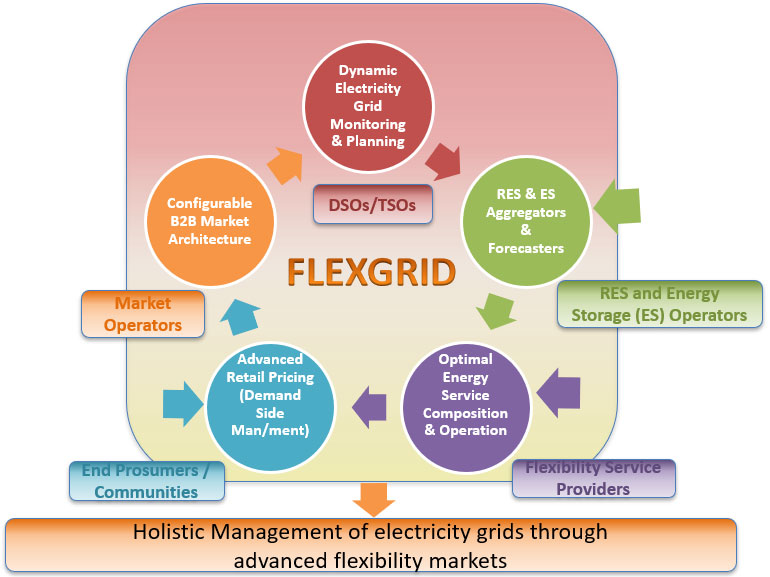by Nikolaos Efthymiopoulos, Prodromos Makris, Emmanouel Varvarigos (National Technical University of Athens)
Circularity and sustainability in modern smart grids require open data models that can support dynamic and efficient distribution-network-aware energy management. In this context, the FLEXGRID [L1] project is developing a digital platform that will offer digital energy services (DESs) that help energy sector stakeholders (i.e., Distribution System Operators (DSOs), Transmission System Operators (TSOs), market operators, Renewable Energy Sources (RES) producers, retailers, flexibility aggregators) to: (i) automate and optimise the planning, operation and management of their systems and assets, and (ii) interact in a dynamic and efficient way with the electricity system and other stakeholders.
The large-scale integration of Distributed Energy Resources (DERs), such as PV/wind generation (RES), electric vehicles (EVs), energy storage systems (ESS) and demand side management (DSM) equipment in distribution networks poses new challenges and opportunities for the power sector, as stated in the EU Clean Energy Package [1]. In this context, the FLEXGRID project is investigating the constraints of the current smart grid architecture that prevent large scale DER integration in distribution networks and consequently mitigates circularity and sustainability in modern smart grids.
The first reason is that DSOs use conservative constraints in distributed DER installation to ensure reliable and secure operation of their network. The root cause of this conservatism is the inability of DSOs to dynamically and accurately monitor and manage their networks. The development of a dynamic and accurate distribution network (DN) monitoring system and of an efficient and dynamic DN management system is therefore the first step towards mitigating this conservatism.
A second reason is that even in cases where DSOs dispose distribution management systems with appropriate DN monitoring capabilities, the lack of intelligence that would allow the efficient and dynamic interaction with DER operators (i.e., RES producers, retailers, flexibility aggregators) hinders DER investments. Consequently, the DN-related costs remain high (usually driven by DN upgrades with high CAPEX). In this context, FLEXGRID develops advanced DESs relevant to the operation of distribution level flexibility markets (DLFMs), aiming to facilitate the efficient management of DNs and the reduction of distribution network management cost.
Another issue tackled in FLEXGRID is the inefficient investment planning and management of DER assets. To this end, FLEXGRID evolves existing smart grid architectures, which are not able to provide information related to the electricity grid topology and the market conditions to DER investors, by addressing the aforementioned shortcomings. From this perspective, FLEXGRID exploits: (i) topology and monitoring information from the networks that it manages, and (ii) data analytics from the market that it operates in order to provide DESs useful for the design of optimal DER investment strategies and optimal DER portfolio management.
Beyond these innovation levels, FLEXGRID copes with a major inefficiency in today’s smart grids, which is the lack of interaction between TSOs and DSOs. Today, the TSO is the main actor procuring flexibility from flexible units to ensure system stability. However, in the future, according to [2], DSOs will also be expected to procure flexibility to solve issues in their networks. As DSOs and TSOs might use the same sources of flexibility, this flexibility should ideally be used in a coordinated way. Different market-based and non-market-based approaches can be used by the TSO and the DSOs for the coordination of flexibility. When using flexibility to cope with a given grid operation challenge, this might have an impact on other aspects of grid operation. For example, the activation of DN-level flexibility for system balancing by the TSO might cause congestion in the distribution grid. Another example is the activation of DN-level flexibility by a DSO to solve a local congestion problem, which may cause higher re-dispatch costs at the transmission network (TN) level.
Another problem of ineffective TSO/DSO interaction in today’s smart grids is that of suboptimal economic dispatch decisions. These are often made by the DSOs or their issuing dispatch orders to DER operators that: (i) are infeasible, due to DN constraints, and/or (ii) in conflict with dispatch instructions sent by the DSO to end energy prosumers. DSOs, on the other hand, have observability into distribution system operations but, to date, have little to no experience in creating economically optimal system operations. Moreover, DSOs have little or no observability into transmission system conditions, and, in many cases, into the investment or operation decisions of DER owners. As a result, DSOs (and, equally often, TSOs) lack knowledge about the DER and DSM potential, which may act in support of system operations. This has led to discussions about how to coordinate DSO operations with consumers, DER operators and TSOs.

Figure 1: The FLEXGRID concept.
In this new landscape, FLEXGRID focuses on four major research gaps.
The first examines the operation of existing energy markets and the evolution of their architectures in depth by focusing on the interaction between TSOs and DSOs. It also unfolds around the development of advanced market clearing and pricing algorithms that can adequately model the underlying distribution system and ensure market efficiency by considering modern DER models (e.g., ESS, DSM).
The second gap addressed by FLEXGRID is the development of DESs towards efficient aggregation of end user’s DERs. This alternative facilitates their optimal and parallel usage of their capacity in multiple energy markets according to FLEXGRID’s innovative energy market architecture.
The third research gap relates to the development of DESs that contribute to the optimal operation of DERs and the advanced planning of DER investments according to a sophisticated and data-driven examination of: (i) innovative FLEXGRID’s markets, (ii) DN/TN topology, and (iii) competition.
The fourth research thread focuses on the monitoring and management of the transmission and the distribution networks in smart grids and in resolving problems related to the grid upgrades with respect to market power mitigation and flexibility exploitation. It co-optimises network upgrades and flexibility investments.
Link:
[L1] https://flexgrid-project.eu/
Reference:
[1] “Clean energy for all Europeans package” https://ec.europa.eu/info/news/clean-energy-all-europeans-package-completed-good-consumers-good-growth-and-jobs-and-good-planet-2019-may-22_en, accessed 03 March 2021
Please contact:
Nikolaos Efthymiopoulos
National Technical University of Athens, Greece











